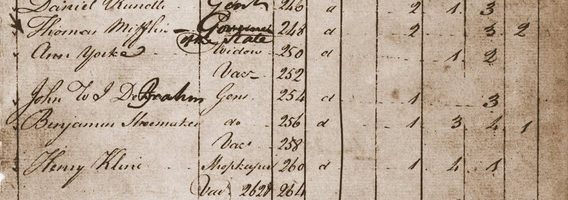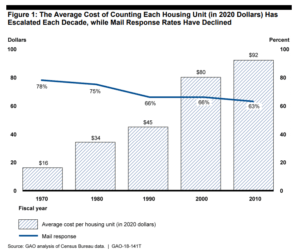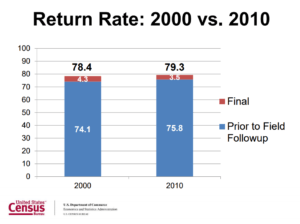Losing at the Census Bureau is as easy as 1, 2, 3…

Despite $600 billion on the line, the U.S. Census Bureau is stuck in the stone age of data collection and analysis.
Most people know the U.S. Constitution requires a census be conducted every 10 years. [1] But few realize that census results determine how $600 billion federal funds are allocated. [2]
With $600 billion on the line, one would think accurate results are important. Unfortunately, the U.S. Census Bureau is stuck in the stone age of data collection and analysis. The most recent census—the 2010 decennial—was a “pen and pencil” census that relied on households filling out and returning mailed questionnaires. [3] For non-reporting households, temporary workers were dispatched across America to physically obtain census data. [4]
Not surprisingly, the 2010 decennial was the costliest census ($12.3 billion), and had dismal response and return rates: [5]
As attention turns to the 2020 decennial, the Census Bureau claims four new “innovation areas” will help modernize the next census: [6]
(1) Using geographic information systems and aerial imagery to canvas addresses (instead of dispatching census employees to physically check 11 million census blocks);
(2) Adding phone and internet response options to increase self-response rates;
(3) Utilizing administrative records and third-party data to improve the quality of addresses, improve advertising effectiveness, validate online responses, and reduce field employee follow-up activities; and
(4) Adopting work automation/optimization software to more efficiently manage fieldwork.
While these are steps in the right direction, they fall short of modernizing the 2020 decennial, or justifying its $15.6 billion price tag. Instead, here are some suggestions for improving census results.
First, Congress should enable a rolling census, which could collect and distribute census data in a continuous fashion, and be supplemented by cheaper statistically grounded surveys. [7] A rolling census would minimize labor costs from field operators (the 2010 decennial hired 635,000 temporary workers to investigate non-responses). [8]
Second, the Census Bureau should be more proactive in using administrative records and third-party data. For example, the Census Bureau could issue federal grants to universities (who are far more experienced at analyzing big data) to scrape publicly available data on a state-by-state basis. EDI could be established between the Census Bureau and state agencies, which would automate transmission of relevant census data (e.g., vehicle registrations, birth and death certificates, state tax returns).
Third, the Census Bureau should lobby for the creation of a national ID system. While some claim national IDs raise civil liberty concerns, [9] it is likely that tech and financial companies (not to mention hackers) already can assemble fairly accurate databases, with far better accuracy than the 2010 decennial’s 79.3% response rate. A national ID system not only would remove billions from the Census Bureau’s budget, but also would make other federal and state agencies more efficient.
Unfortunately, the Census Bureau remains decades behind current data collection and analysis technologies, and is trying to catch up with baby steps.
[1] U.S. Constitution, Article 1, Section 2. See also U.S.C. Title 13, available at https://www.law.cornell.edu/uscode/text/13; Kat Eschner, “The First Census Only Asked Six Questions,” Smithsonian.com (Aug. 2, 2017), https://www.smithsonianmag.com/smart-news/first-us-census-only-asked-six-questions-180964234 (noting that “America’s founders agreed that the census was important, but it wasn’t long”).
[2] Robert Shapiro, “The 2020 Census may be wildly inaccurate—and it matters more than you think,” Brookings Institution (Aug. 31, 2017), https://www.brookings.edu/blog/fixgov/2017/08/31/the-2020-census-may-be-wildly-inaccurate-and-it-matters-more-than-you-think; see also Kyle Morrill, “2020 Census Goes Digital,” Montana Business Quarterly 54 (Fall 2016) 2.
[3] Statement of Wilbur Ross, Secretary of Commerce, before the U.S. House Committee on Oversight and Government Reform (Oct. 12, 2017), available at https://oversight.house.gov/wp-content/uploads/2017/10/Written-SWLR-HOGR-Testimony-FINAL.pdf.
[4] Statement of David A. Powner, Director Information Technology, U.S. Government Accountability Office, before the U.S. House Committee on Oversight and Government Reform (Oct. 12, 2017), available at https://oversight.house.gov/wp-content/uploads/2017/10/GAO_Goldenkoff-and-Powner_Testimony_2020-Census.pdf.
[5] The first chart is from David A. Powner’s testimony (see reference above). The second chart is from the U.S. Census Bureau’s “Census Coverage Management” report, which was issued on May 22, 2012 and is available at https://www.census.gov/2010census/news/pdf/20120512_ccm_newsconf_slides.pdf.
[6] U.S. Census Bureau, 2020 Census Operational Plan—Version 3.0 (October 2017), available at https://www.census.gov/programs-surveys/decennial-census/2020-census/planning-management/planning-docs/operational-plan.html.
[7] See, e.g., Joseph F. Coates, “Moving the census into the 21st century,” Technological Forecasting & Social Change 113 (2016) 44-46.
[8] “Door-to-Door Visits Begin for 2010 Census,” U.S. Census Bureau News Release (April 30, 2010), https://www.census.gov/2010census/news/releases/operations/door-to-door-visits-begin.html.
[9] See, e.g., “5 Problems with National ID Cards,” American Civil Liberties Union, available at https://www.aclu.org/other/5-problems-national-id-cards (accessed Jan. 29, 2017) (noting that national IDs “will lead to a slippery slope of surveillance and monitoring of citizens”).





Very interesting and worrisome. Perhaps this is a space for private-public partnerships. Like we discussed about how Waymo can tie online activity to offline actions, the information that tech companies have could greatly improve the speed and accuracy of studies. Specifically data on the movement of people throughout the country and how communities have formed and changed over time could be particularly interesting.
I also wonder if methods and tech developed by the US Census could serve as a model for other agencies like Bureau of Labor Statistics. Perhaps there are methods that the BLS already deploys that the Census could adopt. Regardless, I feel $15.6 bil could be put to better use than perpetuating an arcane system.
Great points Sean. Government statistics is the perfect place for private-public partnerships. However, I think there are two big obstacles. First and obviously are the privacy concerns: what are the risks of giving Alphabet, Facebook, Amazon, SAP, etc., access to government resources and private citizen information? But in reality these companies already have a trove of information on most U.S. residents.
Instead, I believe the bigger obstacle is the territorial nature of federal agencies. For example, you mention the Bureau of Labor Statistics. Why do we have separate data collection/analysis functions at a range of federal agencies? While I’m sure the Department of Defense and the DOJ have access to information from most federal agencies, several agencies operate their own internal registries (e.g., IRS, Census Bureau, Social Security Administration, Post Office). Consolidation into one agency would prevent a lot of value destruction in the federal government.
Great read, Hans. I’m curious about the idea for a national ID – isn’t that what a social security number is? Also it seems to me that issuing a mandate for national IDs in this age when people are increasingly suspicious of mass surveillance could be difficult. Partnering with the private sector like phone companies or banks also seems like a stretch since all companies want to keep their data as private as possible to 1) maintain customer trust, 2) preserve any competitive advantage from the information, and 3) to avoid going down the slippery slope of revealing more and more data to the government (think Apple’s reasoning against the FBI last year). I do see the advantages in having a national ID system if the SSN doesn’t already fulfill that role, but BBOP has made me reevaluate just how hard it is to make any operational changes in the government, and so my hesitance is mainly a reflection of those concerns.
Hi DF – the social security system is not comprehensive. While U.S. citizens have a SSN, only non-citizens who are authorized to work in the U.S. are able to get a SSN. While SSN basically serve as a national ID, my suggestion is to develop a national ID card and registry system, which would be limited to very basic information — I think only recording name, date of birth, current and past addresses, passport #, and SSN, would be sufficient. For people who are concerned about privacy, you only have to look at recent hacks such as Experian (2017 – 143 million people) and OPM (2015 – 21.5 million people), where SSNs and other personal info was stolen. And I agree it’s true that operational changes in government are hard to effect, but that doesn’t mean government should stubbornly persist in the status quo without trying to make things better.
Thanks, Hans. This is pretty pathetic by the Census Bureau – I wonder what the politics of this are behind closed doors. Surely there are some groups that don’t want certain people counted for whatever reason. I also find it amazing that this day in age with self-driving cars on the horizons and iPhones that are mindblowingly powerful that a developed country is unable to count the number of people within its borders. This is a definite failure of bureaucracy, though childish behavior on the part of many respondents in the 2010 census (see: Michele Bachmann) certainly didn’t help. Privacy issues also play a major role here, including responses by undocumented immigrants who understandably feel uncomfortable responding to the census. Given some of the controversies surrounding the last census, the government is really under a lot of pressure to get the 2020 census right, and their use of technology will be critical.
Hi Zach – You’re totally right about the intense politicization of the census! Part of the problem is that, since the census information is used to distribute $600 billion federal funds each year, it asks for politically-sensitive information, such as race and gender. And there is intense debate every decade about what questions should or shouldn’t answer.
On Michelle Bachmann… she clearly forgot that Congress gets to enact laws! While the Constitution does merely say that an enumeration has to happen every 10 years, 13 U.S.C. § 5 gives the Secretary of Commerce the authority to “prepare questionnaires” and “determine the inquiries, and the number, form, and subdivisions thereof, for the statistics, surveys, and censuses” (by the way, Michelle Bachmann conveniently left out that the census provision of the Constitution also excluded Indians and counted “other persons” (i.e., slaves) as 3/5 a person).
Thanks for the post Hans! This would be a really cool problem to solve. I think that we shouldn’t just think about this issue from a cost perspective but also from a productivity standpoint. For instance, if the Census Bureau was able to provide accurate real-time data, businesses across all industries would be able to forecast demand better and entire supply chains would become more efficient. I think the U.S. Census Bureau should think of themselves as a key enabler of economic progress via the provision of high quality information to society.
Hi SAG – You’re absolutely right! The U.S. Census Bureau actually does make microdata available, but restricts data use to research purposes, and only makes the data available at Federal Statistical Research Data Centers (RDCs). There are 29 RDCs across the U.S., and most are accessed for research by universities, non-profits and other government agencies. In addition to census microdata, researchers also can access data from the Bureau of Labor Statistics and the National Center for Health Statistics at RDCs.
https://www.census.gov/ces/dataproducts/restricted_data.html
https://www.census.gov/about/adrm/fsrdc/locations.html